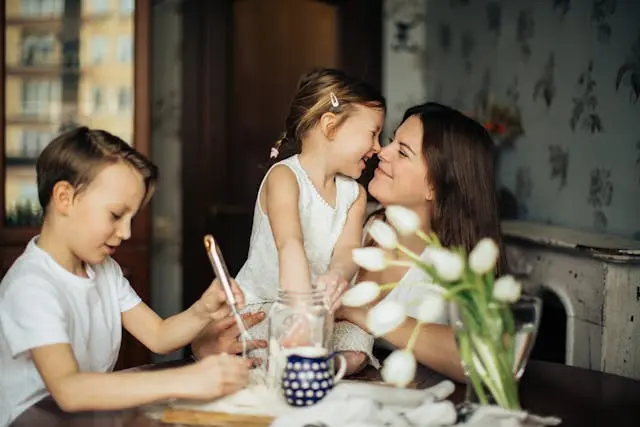In today’s rapidly changing world, we all share a common goal: to provide the best possible future for our children. As we face increasing environmental challenges, one of the most impactful ways we can contribute to this brighter future is by creating a more sustainable home. This isn’t just about being eco-friendly; it’s about nurturing an environment where our children can thrive, learn valuable life lessons, and develop a deep connection with the world around them.
Let’s embark on this journey together, exploring practical and inspiring ways to transform our homes into sustainable havens that will benefit not only our families but also the planet we all call home.
Importance of a Sustainable Home
Before we dive into the how-to’s, let’s take a moment to reflect on why creating a sustainable home is so crucial for our children’s future.
Imagine a world where clean air, fresh water, and abundant natural resources are the norm, not the exception. A world where our children and grandchildren can enjoy the same beautiful landscapes, diverse wildlife, and healthy ecosystems that we cherish today. This is the world we’re striving to create when we commit to sustainability.
By making our homes more sustainable, we’re not just reducing our environmental impact; we’re setting a powerful example for our children. We’re teaching them to be mindful consumers, responsible citizens, and stewards of the Earth. These lessons will stay with them long after they’ve left the nest, shaping their values and decisions throughout their lives.
Moreover, a sustainable home is often a healthier home. By reducing toxins, improving air quality, and embracing natural materials, we’re creating an environment that supports our children’s physical well-being. And let’s not forget the financial benefits – many sustainable practices can lead to significant savings over time, providing more resources for our families’ needs and dreams.
Now that we understand the ‘why,’ let’s explore the ‘how’ of creating a more sustainable home for our children.
Energy Efficiency: The Foundation of a Sustainable Home
- One of the most impactful ways to make our homes more sustainable is by improving energy efficiency. This not only reduces our carbon footprint but also teaches our children the value of conserving resources.
- Start by conducting an energy audit of your home. Many utility companies offer this service for free or at a low cost. This will help you identify areas where you’re losing energy and provide recommendations for improvements.
- Consider upgrading to energy-efficient appliances. Look for the ENERGY STAR label when shopping for new refrigerators, washing machines, or dishwashers. These appliances use significantly less energy than older models, which means lower utility bills and a smaller environmental impact.
- Lighting is another area where small changes can make a big difference. Replace old incandescent bulbs with LED lights, which use up to 75% less energy and last much longer. Involve your children in this process – let them help choose new light fixtures or bulbs, explaining the benefits as you go.
- Insulation is key to maintaining a comfortable temperature in your home without overworking your heating and cooling systems. Check your attic, walls, and floors for adequate insulation. This might seem like a boring topic, but you can make it fun for kids by comparing it to putting on a warm, cozy sweater for the house!
- Don’t forget about windows and doors. Drafts can significantly increase your energy consumption. Teach your children how to check for drafts using a candle or a piece of tissue paper. Make it a game to find and seal these energy-wasting culprits.
Water Conservation: Every Drop Counts
- Water is one of our most precious resources, and teaching our children to use it wisely is crucial.
- Start by fixing any leaky faucets or pipes – even a small drip can waste gallons of water over time. Involve your kids in this process, explaining how much water can be saved by this simple action.
- Install low-flow showerheads and faucet aerators. These devices can reduce water usage by up to 60% without sacrificing water pressure. Challenge your children to take shorter showers or turn off the tap while brushing their teeth. You could even make it a friendly competition to see who can save the most water!
- Consider installing a rainwater collection system. This can be as simple as a rain barrel to collect water for your garden, or as complex as an integrated system for non-potable household use. Involving your children in watering plants with collected rainwater can be a fun and educational activity.
- If you have a garden, choose native plants that are adapted to your local climate and require less watering. This is a great opportunity to teach your children about local ecosystems and the importance of biodiversity.
Waste Reduction: Embracing the Three R’s
- Reducing, reusing, and recycling are fundamental principles of sustainability that are easy for children to understand and practice.
- Start by conducting a waste audit with your family. Sort through your trash and recycling to see what you’re throwing away and brainstorm ways to reduce waste.
- Encourage your children to use reusable water bottles, lunch boxes, and shopping bags. Make it fun by letting them choose their own or even decorate plain ones. Explain how these small actions can prevent hundreds of disposable items from ending up in landfills each year.
- Set up a comprehensive recycling system in your home. Create clearly labeled bins for different materials and involve your children in the sorting process. You could even turn it into a game or challenge.
- Composting is another great way to reduce waste and create a valuable resource for your garden. Set up a compost bin in your backyard or use a countertop composter for apartment living. Let your children help add kitchen scraps and watch as they transform into rich soil.
- Consider starting a family project to upcycle items that would otherwise be thrown away. Old jars can become candle holders, worn-out clothes can be turned into cleaning rags or stuffed toys. This not only reduces waste but also nurtures creativity and problem-solving skills in your children.
Sustainable Food Choices: Nourishing Bodies and the Planet
The food we eat has a significant impact on both our health and the environment.
- Encourage your children to make sustainable food choices by involving them in meal planning and preparation.
- Start a small vegetable garden, even if it’s just a few pots on a windowsill. Let your children choose what to grow, care for the plants, and enjoy the fruits (or vegetables) of their labor. This teaches them about where food comes from and the effort involved in producing it.
- When shopping, opt for locally produced, seasonal foods. Explain to your children how this supports local farmers and reduces the carbon footprint associated with transporting food long distances. Make trips to farmers’ markets a fun family outing.
- Reduce meat consumption by introducing ‘Meatless Mondays’ or exploring plant-based recipes together. This doesn’t mean going fully vegetarian, but rather finding a balance that’s better for both your family’s health and the planet.
- Teach your children about food waste and how to avoid it. Plan meals carefully, use leftovers creatively, and learn proper food storage techniques together. You could even start a family challenge to see how much you can reduce your food waste each week.
Eco-Friendly Transportation: Moving Towards a Cleaner Future
While not strictly part of your home, how we move around has a big impact on our overall sustainability.
- Encourage walking, cycling, or using public transportation for short trips. This not only reduces emissions but also promotes physical activity and connection with your community.
- If you need to use a car, consider carpooling or switching to an electric or hybrid vehicle. Involve your children in the decision-making process, explaining the environmental benefits of different transportation options.
- For longer trips, discuss the environmental impact of air travel and explore alternatives like train travel when possible. When you do fly, look into carbon offset programs and explain their purpose to your children.
Creating a Non-Toxic Environment: A Healthier Home for Growing Bodies
Many conventional cleaning products, paints, and furnishings contain harmful chemicals that can affect indoor air quality and our health. Opt for natural, non-toxic alternatives whenever possible.
- Make your own cleaning products using simple ingredients like vinegar, baking soda, and essential oils. This is a great activity to do with your children, teaching them about chemistry while creating safer cleaning solutions.
- When renovating or redecorating, choose low-VOC paints and finishes. Opt for furniture made from sustainable materials and without harmful flame retardants or formaldehyde. Explain to your children why these choices matter for both their health and the environment.
- Bring nature indoors with houseplants. Not only do they improve air quality, but caring for plants can also teach children responsibility and connection with nature.
Embracing Renewable Energy: Powering a Sustainable Future
- If possible, consider installing solar panels on your home. While this can be a significant investment, it’s one that pays off in the long run, both financially and environmentally. Involve your children in tracking your energy production and use, turning it into a learning opportunity about renewable energy.
- If solar panels aren’t feasible, look into switching to a green energy plan with your utility company. Many now offer options to source your electricity from renewable sources.
- Teach your children about different forms of renewable energy through fun projects. Build a small wind turbine or solar-powered toy car together. These hands-on activities can spark a lifelong interest in sustainable technology.
Cultivating a Sustainable Mindset: The Most Important Legacy
Perhaps the most crucial aspect of creating a sustainable home for your children is fostering a mindset of environmental stewardship.
- Encourage curiosity about the natural world. Take nature walks, visit local parks, or go camping to help your children develop a personal connection with the environment.
- Discuss environmental issues at an age-appropriate level. Instead of focusing on doom and gloom, emphasize the positive changes that people are making and how your family can be part of the solution.
- Encourage your children to take action. Support their involvement in school or community environmental projects. Help them write letters to local representatives about environmental issues they care about. Show them that their voice matters and that they have the power to make a difference.
- Lead by example. Let your children see you making sustainable choices in your daily life. Explain your decisions and the reasoning behind them. Your actions will speak louder than words and will shape your children’s values and behaviors.
Conclusion: A Journey of Love and Responsibility
Creating a sustainable home for our children is not just about changing light bulbs or recycling more. It’s about reimagining our relationship with the world around us and instilling values that will guide our children throughout their lives.
Remember, perfection is not the goal. Every small step towards sustainability is a victory. Celebrate your successes, learn from your challenges, and keep moving forward. Your efforts today are creating ripples that will extend far into the future, shaping not only your children’s lives but the world they will inherit.
By creating a more sustainable home, you’re giving your children an incredible gift – the tools, knowledge, and values to be responsible stewards of our planet. You’re showing them that their actions matter, that they have the power to make a difference, and that taking care of our Earth is an act of love – for themselves, for their community, and for future generations.
So let’s embark on this journey together, with hope, determination, and love. Let’s create homes that nurture not only our children but also the planet they call home. Because in doing so, we’re not just creating sustainable homes – we’re cultivating a sustainable future for all.



